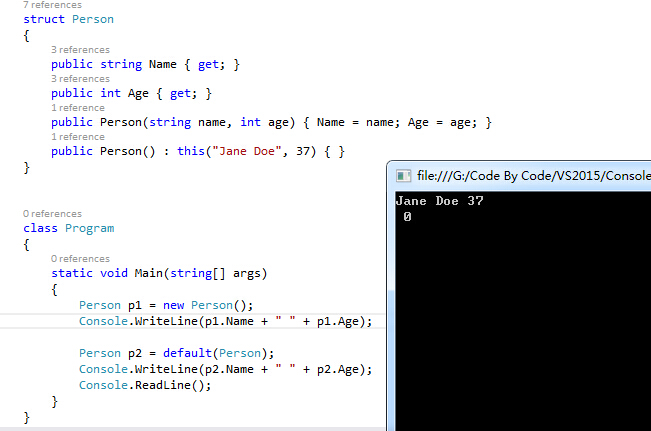C#6.0特性(快来围观)
1、自动属性的增强
1.1、自动属性初始化 (Initializers for auto-properties)
C#4.0下的果断实现不了的。
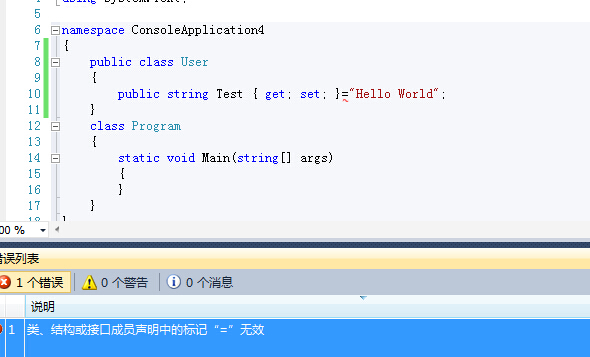
C#6.0中自动属性的初始化方式
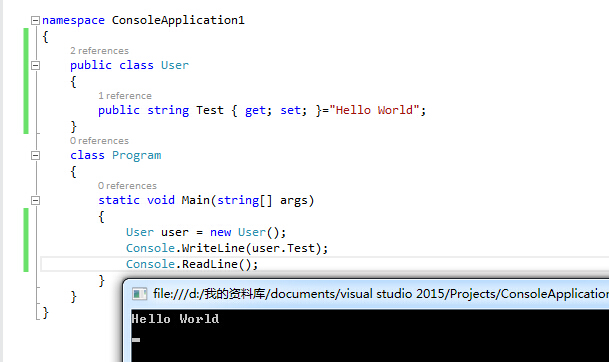
只要接触过C#的肯定都会喜欢这种方式。真是简洁方便呀。
1.2、只读属性初始化Getter-only auto-properties
先来看一下我们之前使用的方式吧
public class Customer { public string Name { get; } public Customer(string firstName,string lastName) { Name = firstName +" "+ lastName; } }
再来看一下C#6.0中
public class Customer
{
public string FirstName { get; }="aehyok";
public string LastName { get; }="Kris";
}
和第一条自动属性初始化使用方式一致。
2、Expression bodied function members
2.1 用Lambda作为函数体Expression bodies on method-like members
public Point Move(int dx, int dy) => new Point(x + dx, y + dy);
再来举一个简单的例子:一个没有返回值的函数
public void Print() => Console.WriteLine(FirstName + " " + LastName);
2.2、Lambda表达式用作属性Expression bodies on property-like function members
public override string ToString()
{
return FirstName + " " + LastName;
}
现在C#6中
public class User
{
public string FirstName { get; set; }
public string LastName { get; set; }
public override string ToString() => string.Format("{0}——{1}", FirstName, LastName);
public string FullName => FirstName + " " + LastName;
}
3、引用静态类Using Static
在Using中可以指定一个静态类,然后可以在随后的代码中直接使用静态的成员
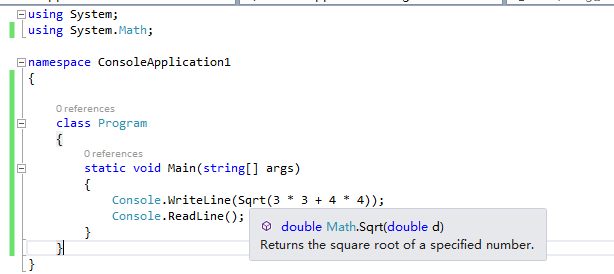
4、空值判断Null-conditional operators
直接来看代码和运行结果
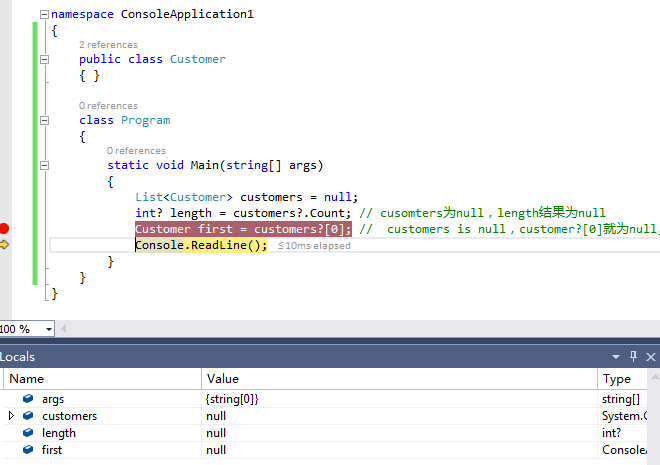
通过结果可以发现返回的都为null,再也不像以前那样繁琐的判断null勒。
5、字符串嵌入值
在字符串中嵌入值
之前一直使用的方式是
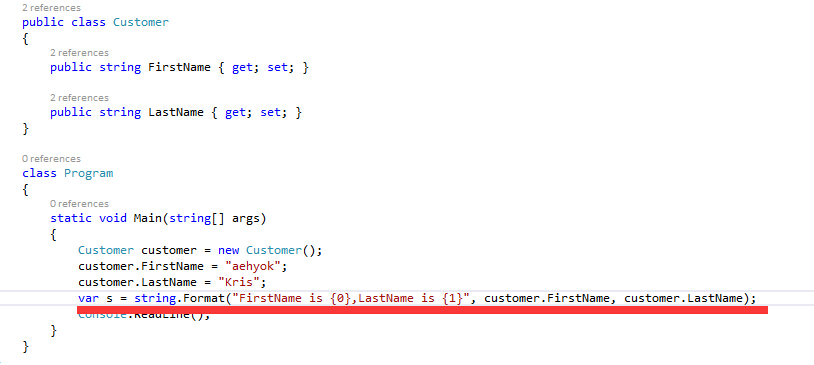
现在我们可以简单的通过如下的方式进行拼接
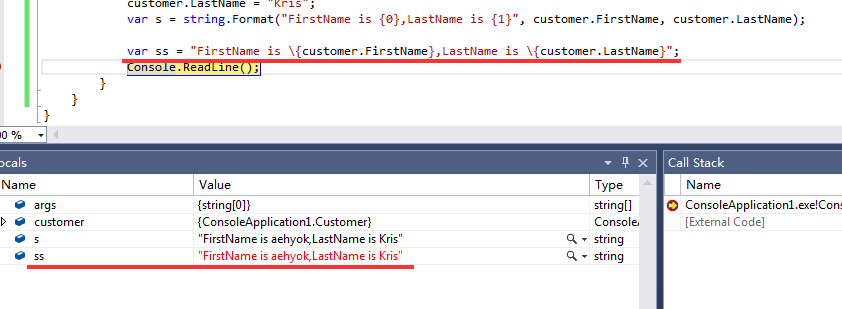
6、nameof表达式nameof expressions
在方法参数检查时,你可能经常看到这样的代码(之前用的少,这次也算学到了)
public static void AddCustomer(Customer customer)
{
if (customer == null)
{
throw new ArgumentNullException("customer");
}
}
里面有那个customer是我们手写的字符串,在给customer改名时,很容易把下面的那个字符串忘掉,C#6.0 nameof帮我们解决了这个问题,看看新写法
public static void AddCustomer(Customer customer)
{
if (customer == null)
{
throw new ArgumentNullException(nameof(customer));
}
}
7、带索引的对象初始化器Index initializers
直接通过索引进行对象的初始化,原来真的可以实现
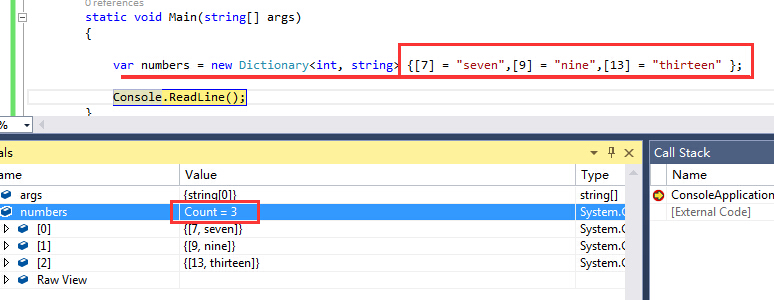
通过这种方式可以发现字典中只有三个元素,所以也就只有这三个索引可以访问额,其他类型的对象和集合也是可以通过这种方式进行初始化的,在此就不进行一一列举了。
8、异常过滤器 (Exception filters)
先来看一个移植过来的方法
try
{
var numbers = new Dictionary<int, string> {[7] = "seven",[9] = "nine",[13] = "thirteen" };
}
catch (ArgumentNullException e)
{
if (e.ParamName == "customer")
{
Console.WriteLine("customer can not be null");
}
}
在微软的文档中还给出了另一种用法,这个异常会在日志记录失败时抛给上一层调用者
private static bool Log(Exception e)
{
///处理一些日志
return false;
}
static void Main(string[] args)
{
try
{
///
}
catch (Exception e){if (!Log(e))
{
}
}
Console.ReadLine();
}
9、catch和finally 中的 await —— Await in catch and finally blocks
在C#5.0中,await关键字是不能出现在catch和finnaly块中的。而在6.0中
try
{
res = await Resource.OpenAsync(…); // You could do this. …
}
catch (ResourceException e)
{
await Resource.LogAsync(res, e); // Now you can do this …
} finally
{
if (res != null)
await res.CloseAsync(); // … and this.
}
10、无参数的结构体构造函数—— Parameterless constructors in structs
